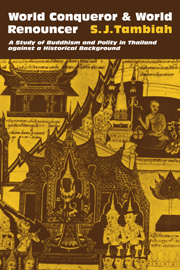 World Conqueror and World Renouncer
World Conqueror and World Renouncer Published online by Cambridge University Press: 10 November 2010
Given the activistic ideological orientations discussed in the previous chapter it is not surprising that in recent years monks have become involved in various community development and missionizing programs – variously called thammathud, thammacarik, thammapatana, and so on. These programs relate to the hill tribes and to the politically sensitive and economically least developed border regions, especially in the northeast, north, and south. (The thammathud program also includes the sending of missions of monks to foreign countries – to Malaysia, Indonesia, to Europe and America – in order to propagate Buddhism there – but we are not concerned with that here.)
Once again the ideological legitimation for this thrust is alleged to be found in impeccable doctrinal texts. Many contemporary monks would refer one to the oft-quoted Buddha's admonition to the first group of monks he sent out to spread the teaching: “Go you forth, O Bhikkhus … to preach the divine life for the benefit and happiness of the world, including gods and men” (Mahavagga, Vinaya Pitaka). Another popular citation is: “The Dhamma and Vinaya of the Tathagata is present in the world for the happiness of the world including gods and men” (Catuhkanipata, Anguttara Nikaya).
Monks ambitious for their religion look back to the glorious age of Emperor Asoka, when Buddhism is believed to have been propagated to all regions of India and also overseas.
To save this book to your Kindle, first ensure [email protected] is added to your Approved Personal Document E-mail List under your Personal Document Settings on the Manage Your Content and Devices page of your Amazon account. Then enter the ‘name’ part of your Kindle email address below. Find out more about saving to your Kindle.
Note you can select to save to either the @free.kindle.com or @kindle.com variations. ‘@free.kindle.com’ emails are free but can only be saved to your device when it is connected to wi-fi. ‘@kindle.com’ emails can be delivered even when you are not connected to wi-fi, but note that service fees apply.
Find out more about the Kindle Personal Document Service.
To save content items to your account, please confirm that you agree to abide by our usage policies. If this is the first time you use this feature, you will be asked to authorise Cambridge Core to connect with your account. Find out more about saving content to Dropbox.
To save content items to your account, please confirm that you agree to abide by our usage policies. If this is the first time you use this feature, you will be asked to authorise Cambridge Core to connect with your account. Find out more about saving content to Google Drive.